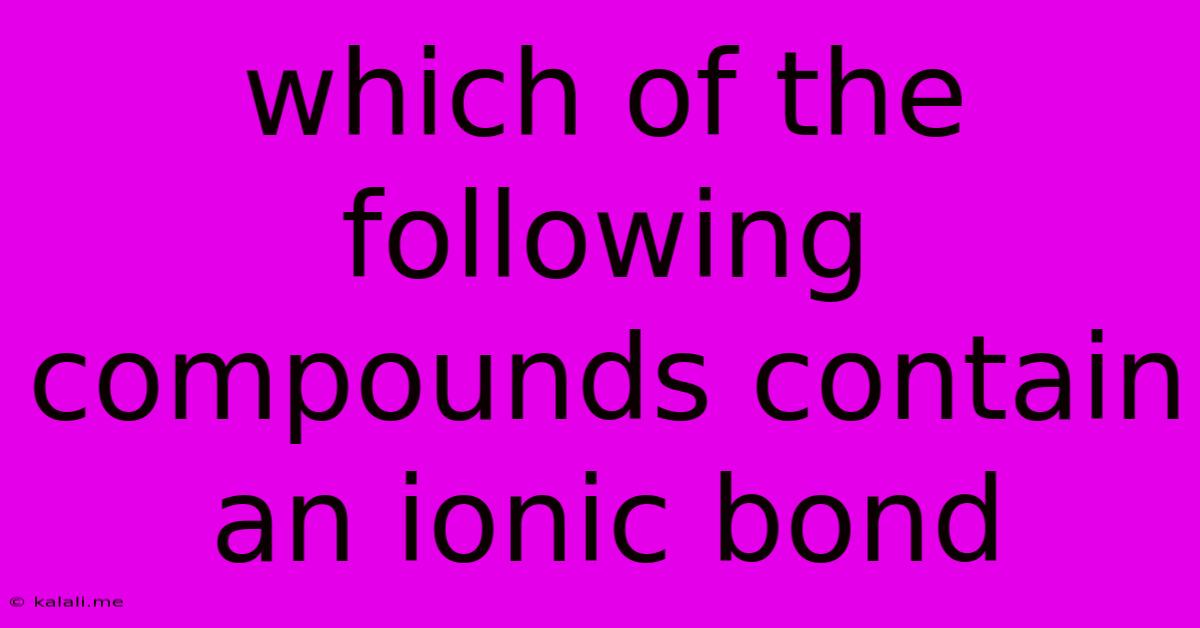Which Of The Following Compounds Contain An Ionic Bond
Kalali
Jun 14, 2025 · 3 min read

Table of Contents
Which of the Following Compounds Contain an Ionic Bond? A Comprehensive Guide
Understanding ionic bonds is crucial for anyone studying chemistry. This article will delve into the nature of ionic bonds and help you identify compounds that exhibit this type of bonding. We'll explore the electronegativity differences that drive ionic bond formation and provide examples to solidify your understanding. This guide will equip you to confidently determine which compounds contain ionic bonds, even when presented with a list of various chemical formulas.
What is an Ionic Bond?
An ionic bond is a type of chemical bond formed through the electrostatic attraction between oppositely charged ions. These ions are created when one atom donates one or more electrons to another atom. The atom that loses electrons becomes a positively charged ion (cation), while the atom that gains electrons becomes a negatively charged ion (anion). This transfer of electrons typically occurs between a metal and a nonmetal, due to the significant difference in their electronegativity.
Electronegativity and Ionic Bonding
Electronegativity is a measure of an atom's ability to attract electrons towards itself in a chemical bond. A large difference in electronegativity between two atoms is a key indicator of ionic bonding. Metals, generally having low electronegativity, readily lose electrons, while nonmetals, with high electronegativity, readily gain electrons.
Identifying Ionic Compounds
To determine if a compound contains an ionic bond, look for the following characteristics:
- Presence of a metal and a nonmetal: This is the most common indicator. Metals are located on the left side of the periodic table, while nonmetals are on the right.
- Large difference in electronegativity: You can consult a periodic table or electronegativity chart to quantify this difference. A difference greater than 1.7 is usually considered indicative of an ionic bond.
- Crystalline structure: Ionic compounds typically form crystal lattices, with ions arranged in a regular, repeating pattern.
- High melting and boiling points: The strong electrostatic forces between ions require significant energy to overcome, resulting in high melting and boiling points.
- Conductivity when dissolved or molten: When dissolved in water or melted, ionic compounds conduct electricity because the ions are free to move and carry charge.
Examples of Compounds with Ionic Bonds:
Let's consider some examples:
-
NaCl (Sodium Chloride): Sodium (Na) is a metal and chlorine (Cl) is a nonmetal. Sodium readily loses one electron to achieve a stable electron configuration, becoming Na⁺. Chlorine gains this electron to become Cl⁻. The electrostatic attraction between Na⁺ and Cl⁻ forms the ionic bond in NaCl.
-
MgO (Magnesium Oxide): Magnesium (Mg) is a metal and oxygen (O) is a nonmetal. Magnesium loses two electrons to form Mg²⁺, while oxygen gains two electrons to form O²⁻.
-
KBr (Potassium Bromide): Potassium (K) is a metal and bromine (Br) is a nonmetal. Potassium loses one electron to become K⁺, and bromine gains one electron to become Br⁻.
-
CaCl₂ (Calcium Chloride): Calcium (Ca) is a metal and chlorine (Cl) is a nonmetal. Calcium loses two electrons to form Ca²⁺, and two chlorine atoms each gain one electron to form two Cl⁻ ions.
Examples of Compounds Without Ionic Bonds:
Conversely, compounds formed primarily through covalent bonding (sharing of electrons) do not exhibit ionic characteristics. Examples include:
- H₂O (Water): Oxygen and hydrogen share electrons to form covalent bonds.
- CO₂ (Carbon Dioxide): Carbon and oxygen share electrons covalently.
- CH₄ (Methane): Carbon and hydrogen share electrons covalently.
Conclusion:
Identifying compounds with ionic bonds involves understanding the fundamental principles of electronegativity and the tendency of metals to lose electrons and nonmetals to gain electrons. By examining the components of a compound and considering the electronegativity difference, you can confidently determine the presence of ionic bonds. Remember to consider the properties of ionic compounds, such as high melting points and electrical conductivity when molten or dissolved, as further confirmation. This knowledge forms a strong base for understanding chemical bonding and the properties of various compounds.
Latest Posts
Latest Posts
-
Which Of The Following Statements Concerning Slate Is Not True
Jun 15, 2025
-
What Are The Factor Pairs Of 100
Jun 15, 2025
-
Which Statement About Case Studies Is True
Jun 15, 2025
-
Difference Between Ascending And Descending Limb Of Loop Of Henle
Jun 15, 2025
-
Difference Between Physical Geography And Human Geography
Jun 15, 2025
Related Post
Thank you for visiting our website which covers about Which Of The Following Compounds Contain An Ionic Bond . We hope the information provided has been useful to you. Feel free to contact us if you have any questions or need further assistance. See you next time and don't miss to bookmark.